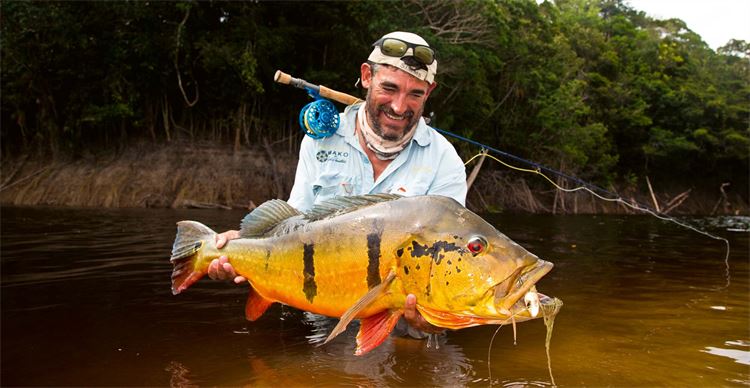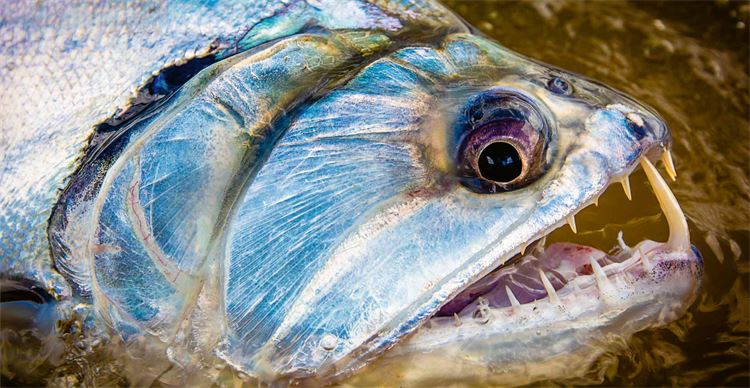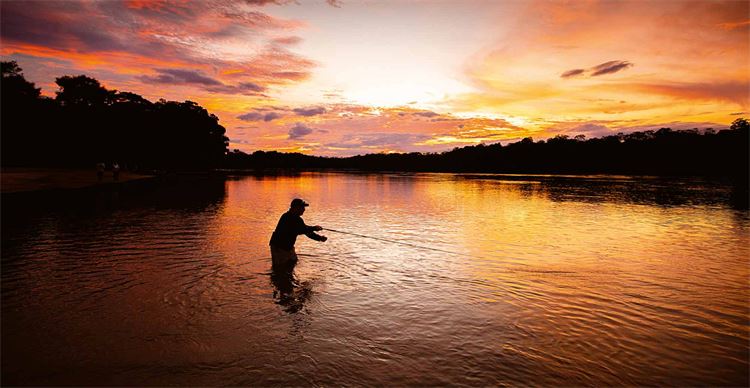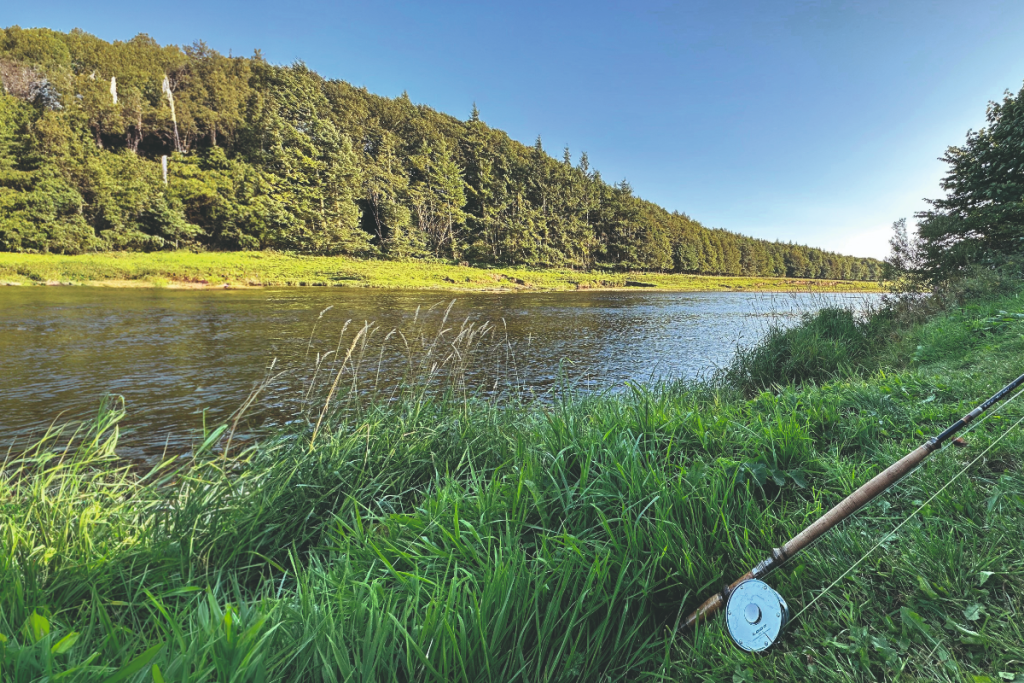South American jungle fishing
Exhilarating, exotic, action-packed... the South American rainforest is a fly fishing wonderland explains Matt Harris.
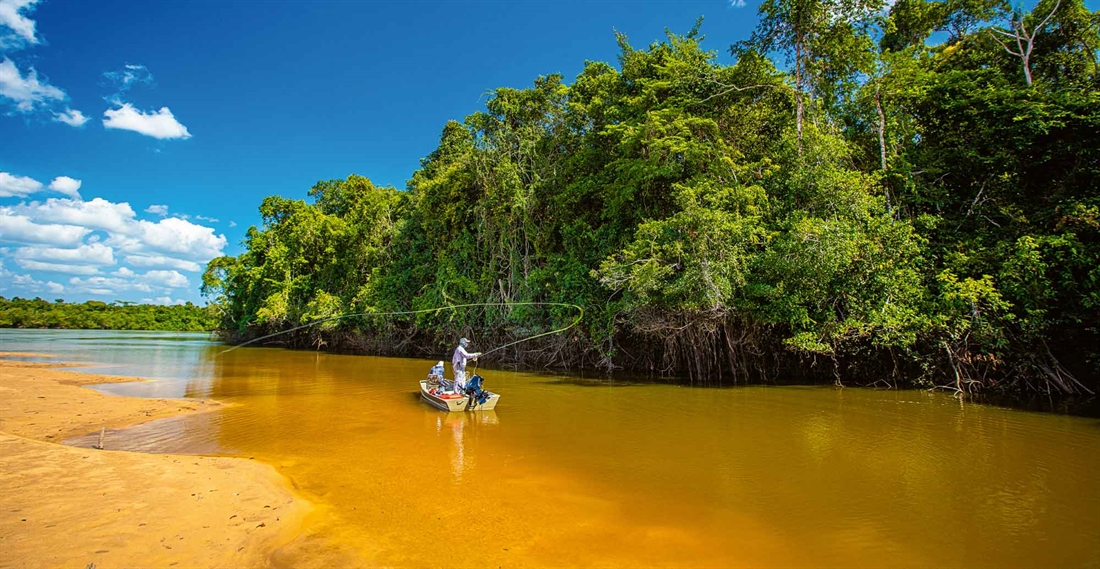
The sun has faded into the west, and another fishless day is meandering to a close. The evening is suddenly grey and bleak, and the air takes on a sharp chill that does little to improve your mood. Your state of the art Spey rod flexes smartly in your hands and you send out yet another elegant cast that unfurls over the gleaming water. It’s easy to be seduced by the beguiling aesthetics of Spey casting, but in truth, you’re tired of your beautiful casts producing nothing. You have come to expect little reward for your exertions. Four days in, and bitter experience tells you that your annual salmon trip has been yet another extravagant waste of time and money…
Close your eyes for a moment and drift off to a place where the air is hot, the water is clear, and the river is full of big, aggressive fish that are queuing up to attack your fly… Let me tell you about the almost impossibly exhilarating fly fishing wonderland of the South American rainforest.
There’s a kaleidoscope of incredible fishing just waiting here, and for the hardened salmon angler, the amount of action is simply hard to imagine. Most of the very best fishing is in our winter months, and the heat of the jungle brings a welcome contrast to the cold, fishless days of our close season.
There are so many species to go at that it really is hard to know where to start.
Let’s start with the peacock bass. These flamboyant brutes are the central staple of the tropical fly fishing experience. Painted in a spectacular array of red, green and gold, these savage brutes are the giant trevally of the rainforest. They maraud truculently across the lagoons and shallow flats, all bravado and swagger, and sight-fishing for them is a tour de force of adrenaline-charged mayhem. These things are insanely aggressive, and the surface takes in particular will have you jumping clean out of your skin.
Get your eye in with some little guys: It’s possible to catch huge numbers of the smaller ‘borboletta’ or butterfly peacocks – even those weighing in at 3–6lb will wolf poppers and streamers alike and give you an astonishing fight for their size.
Once you’ve got a bunch of these little guys under your belt, forsake the numbers game and go hunting the big bad boys of the jungle – ‘tucunare’ peacock bass are the main attraction. They are absolute psychopaths. Show them a large surface popper and watch in awe as they lock onto our fly and explode through the surface in a ferocious, crashing rage. Set up hard and hold on tight as these formidable bruisers rocket into the crackling heat of the jungle, and then try to mess you up in that vast sunken tree. Hold hard and hope that the knots in your 60lb test leader are up to the job…
If you’re lucky, you may get to draw your prize to the boat– finally, here he is, all 20lb of him, resplendent in his freakish, fauvist colour scheme, broad-shouldered and impossibly powerful. Surely, pound for pound, there is no stronger fish swimming in freshwater?
Well, perhaps the ghoulish fanged payara of the Orinoco might just disagree. These silver berserkers are every bit as violent and as savage as they look. Lurking in the frothing rapids of the Orinoco’s mighty currents, they come out of nowhere to hit your fly like a train. Boom!! Jab that rod back hard and do your best to set that hook in the payara’s nightmare jaws. Clear the line as quickly as you can and watch it cascade out into the fast currents.
Suddenly this horror show vampire of a fish clambers up out of the chocolate-coloured water and cartwheels across the surface, burning your thumb, bruising your knuckles and capturing your heart.
Payara can attain 30lb and more, and they fight like tigers. On occasion, they will even take surface patterns… there are few more exciting prospects in all of fly fishing.
Okay. Let’s really mix things up. Let me take you out of the sticky heat and up into the foothills of the Andes. Let’s head deep into the Amazon’s south-western headwaters, in the far south-west of Bolivia. Let me take you to a place where tiny gin-clear streams come tumbling out of the mountains. Streams that feel like they should be populated by beautiful but modestly sized brown trout, but that are actually chock-full of huge, surreal golden brutes, feverishly hunting down the wretched sabalo baitfish in ruthless, malevolent packs.
This is Salminus brasiliensis – the freshwater dorado – and there are few more breathtaking fish in all the world.
Huddle down behind that big smooth boulder and side-arm a stealthy cast into the neck of the pool. Strip fast and watch that menacing shape resolve into a 25lb dorado that is intent on crushing your fly. Whallop! He’s on, jack-knifing up into the air and careering around the pool like a wild thing. Wrestle him hard and feel your hands shaking as you marvel at his bullet-shaped head, his razor teeth and his 24-carat golden fuselage as you revive him in the cool mountain stream.
How about a tougher challenge? Pacu, and their bigger, bolder cousins, the tambaqui, are a fascinating quarry. Don’t be fooled by their docile looks – both can pull like a train. These fish can be tricked with an accurate presentation using a ‘nut’ or ‘fruit’ fly. Dupe the fish into thinking that your fly is sinking after falling off of a tree and they will snaffle it without a second thought. Then hold on tight… These fish have an electric turn of speed and are remarkably hard fighting.
Want to target something tougher still?
Low water on the crystal waters of a remote, northern Brazilian river… Rig up your 12wt with an 80lb leader and a big, white Gamechanger fly with a built-in rattle and let’s go in pursuit of something serious. Be patient and concentrate on peering into the shadows of the scalloped sandbanks of the main river. Pass up your shots at the countless peacocks, and instead wait until you see your target. Here’s one now… and he’s big! Really big!! Put your fly right in front of him… no, right in front of him!! Perfect! Now twitch it right past his nose. Most times, your fly will be ignored, but occasionally your quarry will turn and follow. Tease him with slow, erratic strips and suddenly he accelerates and eats it. In a magical moment, you are attached to one of the jungle’s true juggernauts.
Red-tail catfish can be caught on fly, but it takes infinite patience and a single-minded determination that is hard to sustain when big peacocks are all around. Be warned: even after you’ve hooked one, the hard part has barely begun. Red-tails fight with an astonishing and unstoppable power, and they will frequently break your heart in the timber-strewn depths. If you’re lucky, your guide may swim down into the tree roots to untangle your prize. The sight of veteran guide Borro swimming up from the depths, grinning wildly and pinning my first fly-caught red-tail nonchalantly under his arm – a fish of over 50lb in weight – is one I will not soon forget.
Surubi, or shovel-nosed catfish, are another quarry that can be caught on fly, and they are a little more obliging than red-tails. Again sight-fishing gives you an infinitely greater chance, but be warned: a patient and tenacious approach is sometimes, but not often, rewarded. Surubi are exquisitely and intriguingly beautiful, and well worth the effort involved in catching them.
Arowana, sardinata, wolffish, bicuda, matrinxa… there are a million other fascinating species to target, and most are extremely obliging if your cast is quiet and accurate – intriguing creatures that look like nothing you have ever set eyes on. And all seem to punch way over their weight when hooked.
Perhaps the ultimate jungle trophy is the monstrous arapaima. These fish can grow to absurd sizes – 2, 3, even 4 metres in length – and hooking one is not for the faint of heart. It’s also no easy feat. Despite the fact that arapaima will almost always betray their presence by rolling and gulping air from the surface, they can be infuriatingly tough to tempt with a fly.
Pike fly anglers will recognise the drill: Fish deep and slow, with big flies that retain life and allure even when retrieved at a snail’s pace.
And be patient. When that subtle heaviness finally comes into your line, keep your fly coming until everything locks up tight. Only then should you set that hook with all your might. Step backwards across the threshold of the boat if you can and jab your rod backwards with everything you have. The arapaima’s mouth is predominantly bone, and putting a hook into one is profoundly difficult. Be prepared for any amount of heartbreak, but keep at it and there is every chance that you will finally get a good hook-hold. Stay tight, hope that your hook-hold survives the huge, violent thrashing combustion that’s about to unfold, and you may just catch the biggest fish of your life. These mighty creatures are remarkable – even by the jungle’s standards. A huge broad head, tapering to a monstrous olive fuselage which in turn resolves into a soot-black blade of a tail, embellished with huge, scarlet-tipped scales. Arapaima truly are the ultimate embodiment of the exotic surrealism of fly fishing in the rainforest.
Fly fishing in the rainforest is about much more than the plethora of amazing fish there are to catch, though. Tapirs, freshwater pink dolphin, giant otters, howler monkeys, caiman, anaconda and even jaguars will all compete for your attention. There is a huge array of astonishing bird life, with kingfishers, jabiru storks, macaws and flamboyant hoatzin birds just a few of the highlights.
You will often encounter the indigenous tribes that call the rainforest home, and if you treat them with courtesy and respect, they may show you a glimpse of their way of life, including the spectacular ability they possess to hunt the fish of the river with bow and arrow.
I’ve been lucky to fish far and wide, and I know that many of the world’s fly fisheries are, sadly, in decline. However, there are still a multitude of exhilarating possibilities on offer in the jungle, many of which have yet to be explored. If you know where to look, the fishing is some of the most exciting and exotic on earth.
Be assured: the jungle is nothing to be scared of. You won’t be eaten by piranhas or anacondas – or locals for that matter. While camping offers a way to really embrace the jungle experience, many lodges in the rainforest offer five-star comfort, with air-conditioning, crisp white sheets and excellent WiFi.
Still, come prepared. Keep hydrated and properly protected against the sun, and make sure you have the requisite prophylactic jabs where required. In most of the destinations that I have fished, biting insects are seldom an issue. If you take the required precautions, most of the jungle is actually extremely benign.
Next time you plan a fishing trip, why not forsake the ‘same old same old’, and instead contemplate a new and real adventure. Waking up to the sound of the jungle, with the cool mists rising above the treetops, the sound of a million birds singing across the vast, enchanted forest, and the prospect of an exciting, action-packed day ahead, those drawn-out and fruitless days catching nothing will be long forgotten.
Contact
Matt Harris has been fly fishing in the South American jungle for over 10 years. If you are interested in joining him on a trip, contact him at: mattharris@mattharris.com
www.jungleflyfishing.co.uk
www.mattharrisflyfishing.com
Related Articles
Get the latest news delivered direct to your door
Subscribe to Fieldsports Journal
Elevate your experience in the field with a subscription to Fieldsports Journal, the premium publication for passionate country sports enthusiasts. This bi-monthly journal delivers unparalleled coverage of game shooting, fishing and big game across the UK and beyond.
Each issue offers a stunning collection of in-depth features, expert opinions and world-class photography, all presented in a timeless yet contemporary design.
Save 10% on shop price when you subscribe, with a choice of packages that work for you. Choose from Print & Digital or Digital only with each journal delivered directly to your door or via the app every other month, plus access to past issues with the digital back issue library.






